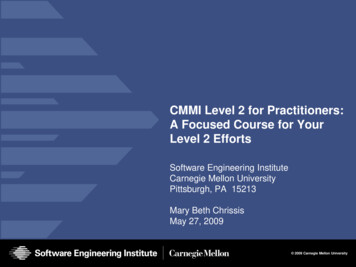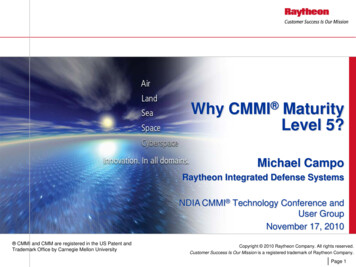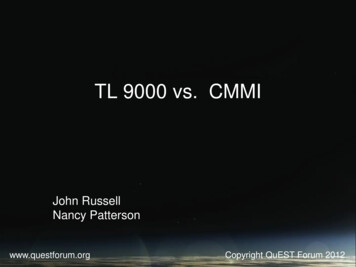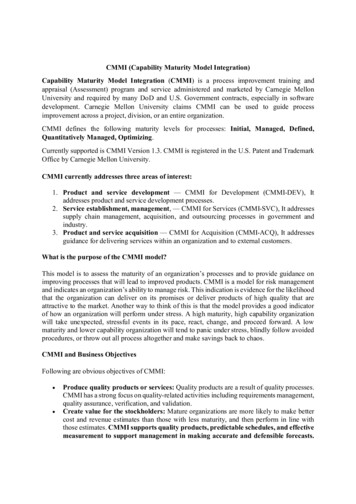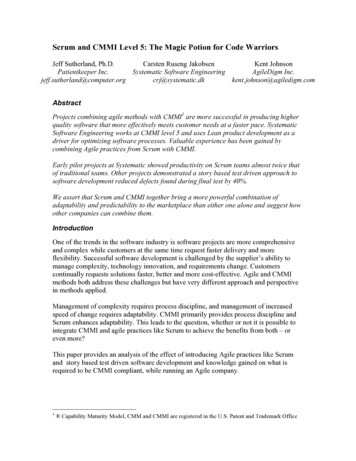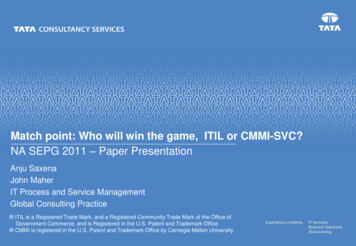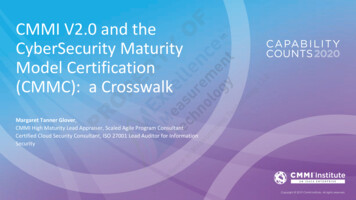
Transcription
CMMI V2.0 and theCyberSecurity MaturityModel Certification(CMMC): a CrosswalkMargaret Tanner Glover,CMMI High Maturity Lead Appraiser, Scaled Agile Program ConsultantCertified Cloud Security Consultant, ISO 27001 Lead Auditor for InformationSecurityCopyright 2019 CMMI Institute. All rights reserved.
Today’s TopicsGoal: Leveraging your CMMI expertise to support CMMC1. Quick CMMC overview2. CMMI and CMMC similarities: Domains, Practice Areas, CapabilityLevels3. CMMI-CMMC direct overlap (Risk Management)4. CMMI-CMMC little to no overlap (Physical Protection)5. Other resources such as (ISO 27001,) NIST 800-171, CERT RMM, etc.All your organization’s hard work for continued CMMI compliancepays off for CMMC!
CMMC Overview
CMMC: What Who When HowWhat: It is a certification: Cybersecurity Maturity Model Certification toa modelWho: Currently applies to anyone who does business with theDepartment of Defense; likely will expand to other areas of federalgovernmentWhen: Being solidified; larger organizations will probably begin Sept2020How: Appraisal providers, method to document, cost, etc. not yetdefined
CMMC: BackgroundApplies to:1. Existing DoD contracts throughout supply chain2. Ability to provide RFPs including team members and subcontractorsThe CMMC’S role is to safeguard FCI requirements specified in the FAR Clause52.204-21 and the security requirements for CUI in the NIST SP 800-171 per theDARS Clause 252.204-7012 (3,4,5).CMMC Goal: stop the information leakage at all levels
CMMC: What you need to knowThe CMMC adds a certification element to verify the implementation ofprocess and practices associated with the achievement of a cybersecuritymaturity level. These Maturity Levels provide increased assurance to the DoDthat a DIB contractor can protect CUI at a level the risk, accounting forinformation flow down to the subcontractors in a multi –tier supply chain.CMMC is a DoD certification process that measures a DIB sector company’sability to protect FCI and CUI, much in the same way the CMMI measures theperformance through building and benchmarking key capabilities to align tobusiness goals for process improvement.The CMMC has been developed by the Software Engineering Institute and the John’s Hopkins University Applied Physics Laboratory
Comparing CMMI V2 Frameworks andTaxonomy to CMMC
CMMI V2 structure
CMMC Hierarchy
CMMC LevelsJust as in CMMI V2, the levels are cumulative. For example, to achieve Level3, you must demonstrate achievement of all the lower levels (Level 1 andLevel 2).
CMMI Process Maturity
Summary of CMMC Maturity Levels
CMMIPractice Areas
CMMC Domains
CMMCDomainsand Capabilities
CMMC Processes and InstitutionalizationThe CMMC maturity levels serve as a way to measure an organization’sprocess maturity or process institutionalization. This characterizes theextent to which an activity is embedded or ingrained in operations ofan organization. Just like II and GOV in CMMI V2.
CMMI V2 and CMMCCorrelations between Domains andPractice areas:Reuse and Extend
Crosswalk of CMMI V2 to CMMC5: Nearly Exact Matches are: Configuration Management Risk Management Incident Response (Service View: Incident Response andPrevention, Causal Analysis and Resolution, Dev View: Verificationand Validation)Domains from CMMC vs. Practice Areas in CMMI V2 matches:5 Nearly Exact 4 Very Close 3 Partial 2 Vague 1 No Match
CMMI PACMMC DomainIncidentResolution andPrevention (IRP)IncidentResolution (IR)Continuity(CONT)SituationalAwareness (SA)Risk andOpportunityManagement(RSK)RiskManagement(RM)
CMMI V2 Risk and Opportunity ManagementRisk: a potential uncertain event that may be harmful or maynegatively impact be achieving objectives (from the CMMI V2glossary).Risk and Opportunity Management Practice Area–Intent: Identify, record, analyze and manage potential risks oropportunities–Value: Mitigate adverse impacts or capitalize on positive impacts toincrease the likelihood of meeting objectives.RSK is at L1, L2 and L3.
CMMC Risk ManagementCMMC Capability 031: Identify and Evaluate RiskLevel 2: P1141:Periodically assess the risk to organizational operations (includingmission, functions, image, or reputation), organizational assets,and individuals, resulting from the operation of organizationalsystems and the associated processing, storage, or transmissionof Federal Contract Information. NIST SP 800-171 3.11.1: CERT RMM v1.2 RISK: SG4:CMMI RSK 2.1 Analyze identified risks or opportunities
CMMC Risk ManagementCMMC Capability 031: Identify and Evaluate RiskLevel 3: Practice 1144Periodically Perform risk assessments to identify and prioritize risksaccording to the defined risk categories, risk sources, and riskmeasurement criteria NIST CSF v1.1 RA CERT RMM v1.2 RISK: SG3 and SG4.SP3CMMI RSK 3.1 Identify and use risk or opportunity categories
Crosswalk of CMMI V2 to CMMC4: Very Close Match Audit and Accountability (Process Quality Assurance, ConfigurationManagement) Recovery (Service View: Continuity) Awareness and Training (Organizational Training)Domains from CMMC vs. Practice Areas in CMMI V2 matches:5 Nearly Exact 4 Very Close 3 Partial 2 Vague 1 No Match
Crosswalk of CMMI V2 to CMMC3: Partial Match Media Protection (Configuration Management) Identification and Authentication (Configuration Management) Access Control (Configuration Management, Monitor and Control) Asset Management (Configuration Management, Monitor andControl, Process Asset Development)Domains from CMMC vs. Practice Areas in CMMI V2 matches:5 Nearly Exact 4 Very Close 3 Partial 2 Vague 1 No Match
Crosswalk of CMMI V2 to CMMC2: Vague Match Maintenance (Continuity) Security Assessment (Strategic Service Management, Monitor andControl, Peer Review, Continuity, Incident Resolution andPrevention) Situational Awareness (Continuity, Incident Resolution andPrevention)Domains from CMMC vs. Practice Areas in CMMI V2 matches:5 Nearly Exact 4 Very Close 3 Partial 2 Vague 1 No Match
Crosswalk of CMMI V2 to CMMC2: Vague Match (continued) Systems and Communications Protection (Strategic ServiceManagement, Monitor and Control, Configuration Management) System and Information Integrity (Configuration Management,Incident Resolution and Prevention, Peer Reviews)Domains from CMMC vs. Practice Areas in CMMI V2 matches:5 Nearly Exact 4 Very Close 3 Partial 2 Vague 1 No Match
Crosswalk of CMMI V2 to CMMC1: No Match Personnel Security Physical ProtectionDomains from CMMC vs. Practice Areas in CMMI V2 matches:5 Nearly Exact 4 Very Close 3 Partial 2 Vague 1 No Match
Example of No Match: Physical ProtectionDomain Physical Protection (PP)Capability (C028) Limit physical access
CMMC Physical ProtectionCMMC ModelAppendices
Using CMMI Expertise When No OverlapManage Physical Protection:1. Determine requirements RDM Requirements Developmentand Management2. Create a protocol TS Technical Solution or PLAN Planning3. Control the protocol CM Configuration Management4. Train the users OT Organizational Training5. Make sure Physical Protection protocols are being followed MC Monitoring and ControlUse the CMMI mechanisms you have in place for all areas ofCMMC!
Summary1) Using CMMI V2 can help you understand the requirements ofCMMC. Taxonomy is very close in Levels, Domain/Practice Areas,and maturity requirements.2) CMMI and CMMC both require institutionalization3) Maturity levels are cumulative and evolutionary4) For areas not closely covered by CMMI, there are other sourcesthat can help an organization understand requirements such as(ISO 27001), NIST 800-171, CERT RMM, etc., that provide examples ofwhat needs to be implemented.5) Reuse and extend your current expertise!
Crosswalk of CMMC to CMMI V2The entire Crosswalk will be Excellence in Measurement Technology isMargaret Tanner Glover CEOKieran Doyle President
information flow down to the subcontractors in a multi -tier supply chain. . CMMI V2 Risk and Opportunity Management . Risk: a potential uncertain event that may be harmful or may . storage, or transmission of Federal Contract Information. NIST SP 800-171 3.11.1: CERT RMM v1.2 RISK: SG4: CMMI RSK 2.1 .


